
CONTENTS
- INTRODUCTION
- GENERAL CARE OF THE POOL
- SAFETY
- MAINTENANCE SCHEDULE
- Weekly Service
- Winter Service
- Re-commissioning
- FILTRATION
- Cleaning or Backwashing the Filter
- Sand Filter Backwashing
- Pump Coarse Strainer
- Valves in Front of Circulation Pump
- CHEMICAL TREATMENTS
- Control of pH
- Control of Disinfection
- Automatic Testing and Dosing Equipment
- Testing, Safety and Handling of Chemicals
- CLEANING YOUR POOL
- Pool Vacuum
- Vacuum to Waste
- If Pool Vacuum Stops Operating
- Automated Cleaners
- POOL HEATERS
- Pool Temperature
- Heat Pump
- Electric Heater
- Heat Exchange
- Gas Heater
- Oil Heater
- Solar Panels
- Indoor Pool Heating
- POOL COVERS
- Heat Retaining Covers
- Winter Debris Covers
- Storage of Covers
- Automatic Covers
- TROUBLE SHOOTING
- Pump Priming
- General
- Heaters

Introduction
Swimming pool owners know that their pool can provide years of fun and exercise opportunities. Being able to relax by a pool can give a tremendous sense of wellbeing, especially for outdoor pools when the sun shines! This handbook has been compiled for pool owners and sets out the maintenance routine for the year. It is written in simple non-technical language, and endeavors to answer some of the queries that will inevitable occur. You are urged to follow the routines explained, so that you can anticipate trouble-free enjoyment of your swimming pool. Now is the time to decide what, if any, aspects of routine maintenance you would prefer your pool builder/ maintenance company to undertake. Make your arrangements in good time to avoid possible disappointment at the last minute. |
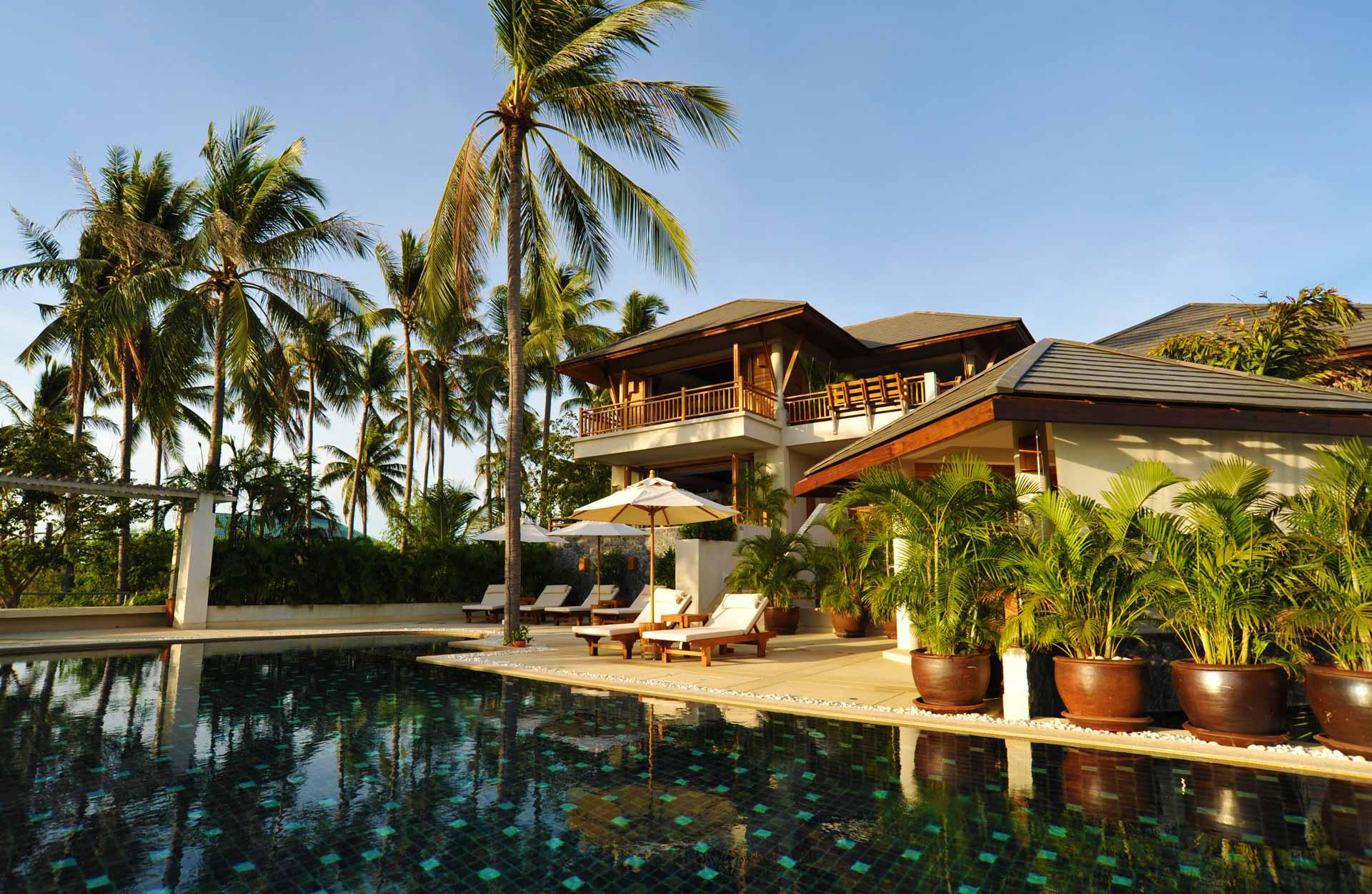
General care of the poolYour swimming pool will give years of trouble-free service, if the following points are remembered:
|
|
Water level in the pool The water level must be at least halfway up the skimmer weir** aperture; otherwise there is a danger that the filter pump will suck in air and lose the ability to pump water (this can damage the pump). When the weather is hot and the pool well used, a lot of water can be splashed out, and there will be additional losses from evaporation and from backwashing the filter. Consequently, keep a check on the water level and top-up as necessary, especially during the peak times in the summer when the pool may lose 50- 80mm (2-3 inches) of water per week. **The surface over which the water flows to the circulating system (usually it is self adjusting for water level changes). |
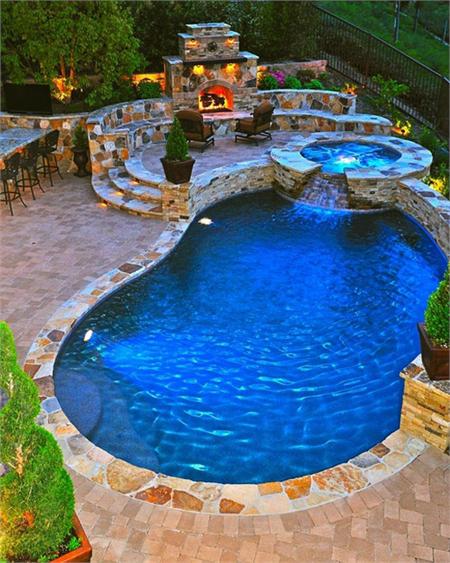
SafetyIt should be obvious to everybody that water is potentially lethal; even a small amount with little depth. Apparently it is on record that a Frenchman survived the sinking of both the Titanic and the Lusitania only to drown in less than six inches of water in his bath! Now that you have a swimming pool, it is important that safety is never far from your thoughts. It is equally important that any measures taken are both practical and not excessive. Adequately securing the boundaries of your property, will minimize the risk of someone coming into your grounds without permission. There are other safety items mentioned below which will reduce the risks further. Consideration should also be given to depth markings and signage for no diving, where pools are not built with a “cage of safety”. Swimming pools should be fun and enjoyed as such. There is not one product on the market which can be described as a completely foolproof safety device, unless perhaps you consider a moving floor with locking pins and even then you must remember to put it in place. Safety devices all rely on a human input; if you have a fence around the pool then YOU must remember to shut and lock the gate. A safety cover will only be effective if YOU remember to put it over the pool, when not in use by bathers. Therefore the best defense against an accident is: Constant vigilance, education and common sense. Continually check swimmers, even older ones, when the pool is in use. Even when the pool is not in use, warn people who are in the vicinity, especially children. Teach EVERYBODY in the family to swim. Teach small children that they must keep away from the pool and only go in when they are told they can and, preferably, supervised by an adult. Do not allow bathers to indulge in horseplay around the pool. Remind yourself constantly to check on pool safety. Never let small children swim without supervision and never allow friends’ children to turn up uninvited. They should only come when you invite them, or by arrangement when their parents can help with the supervision. |
A few general safety tips:
 |

Maintenance scheduleWith a well designed pool and proper planning, cleaning and maintenance tasks should typically take no more than half an hour. For an outdoor swimming pool the maintenance schedule undertaken by yourself, or others, should ideally comprise the following:-
An indoor pool will also require regular servicing. Heating, water treatment and air handling units may require additional specialist servicing. The pool hall will require the usual building type maintenance, depending upon the construction. |
Weekly serviceRegular maintenance of the pool and all its equipment will increase its life and make you aware of problems as they occur, rather than afterwards when costly repair bills may result. You will find that it is much easier to get into a routine if you try to do the servicing on a set day each week rather than on a haphazard basis.
This guide can also be applied to an indoor pool. 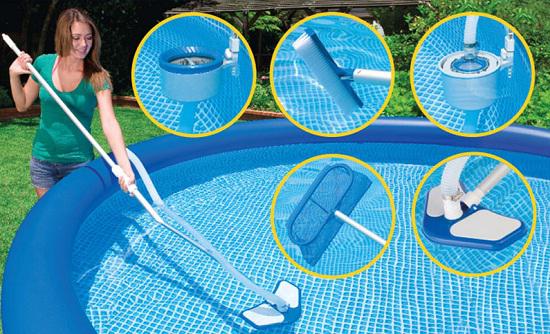 |
|
Winter maintenanceOnce the swimming season has finished you must prepare for winter and the coming months of inactivity – winterization. You must prepare for the cold weather and guard against frost damage, as severe frosts can burst pipes, heaters, and filters. Should any major work be needed then the winter is the time to plan it. The pool should be run and disinfected properly right up until it is winterized, even if the heating is turned off. Once the pool is winterized then the level of regular maintenance required is very much less than during the season. There are no hard and fast rules governing the actual date of winterizing; however the lower ambient temperature becomes the more expensive the heating becomes. Should you have a lot of trees around the pool then you may wish to leave the closedown date until after the leaves have fallen. You must not empty the pool, without professional advice, as hydrostatic pressures can force a concrete structure out of the ground and ground water can lift and displace liners. It would also be a hazard as people falling into an empty pool will face more risk of getting injured than if it were full of water. All floating covers should be removed from the pool, cleaned and carefully dried and stored safely away from vermin. Slatted covers should be cleaned and rolled away for the winter. The fitting of a proper winter cover will help keep the majority of debris and sunlight out of the pool. Winterizing does not mean that the algae will stop growing, so you will need to treat the water until the water temperature drops to about 7°C (42°F). Once the date of winterization is set, you must decide how the equipment is to be left during the winter. There are two options and either one has pros and cons, which can be explained to you by your contractor. Winterizing optionsRemove, clean and store all pool-side equipment and summer covers etc. Check all filtration, heating and cleaning equipment and report on its condition. Advise on the servicing of heaters etc. Remove and store pool cleaner if fitted. De-leaf and clean the pool. Check the chemical values and adjust including a shock dose. A number of chemicals which are long lasting are available for winterization. However the variance of winter weather and temperature affects the longevity of these products and occasional testing is recommended. |
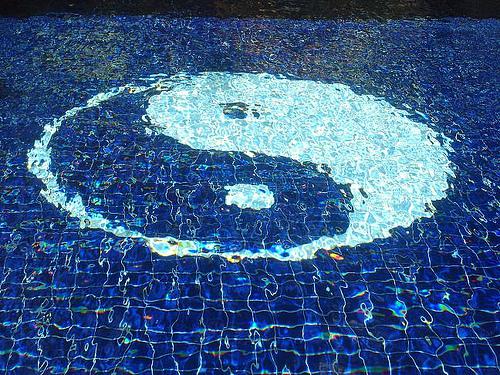
Option 1Lower the level of the pool water* to approximately 30 cms (1ft) below the skimmers as a frost precaution and plug and empty out the skimmer. Store the pumps in a warm environment, only disconnect and re fit electrically if trained, otherwise ask your contractor to fit Lewden plugs (suitable for outdoor use). Isolate all electrics, drain all equipment such as pumps, filters, heaters etc. Generally leave the pool area and plant room in a tidy state. Once the pool has been winterized do not ignore it. Check the water condition regularly and dose if required. This can be easily done by lifting a corner of the cover. Chemicals that dissolve quickly in the summer will be slower reacting in the winter, so pre dissolving them is essential. *Take advice if you have a liner pool. |
|
Option 2Run the filter pump only by time clock control for one hour per day at midday, for example, and set a frost thermostat to 2ºC. This means that if the temperature drops below 2ºC the pump will operate continuously, thus preventing the water from freezing. Install a bypass around the heater and drain the heater, electrically disconnect, or switch off other equipment. If the pump is working the water is moving and freezing will not occur. (You may need to take action if there are power cuts during cold weather, in which case contact your maintenance company). You should backwash the filter, once every 2 months, or if pool water level increases from rainfall. As a result, re-commissioning and winterizing are easier and quicker, as only a vacuum and water balance check is likely to be needed. Your maintenance company will be happy to advise you on the most appropriate course of action and will take away the worry of “doing it yourself” and ensuring that a professional eye is cast over the whole system regularly. They will use a planned maintenance programmed whereby you are advised of the date of re-commissioning well in advance, so there is less rushing about in the spring. |
|
Re-commissioning your poolAt the end of winter and before you start the swimming season the pool will need re-commissioning in order to prepare for the coming season. There are no hard and fast rules laid down as to when to do this, it is entirely up to you. However the following factors should be taken into consideration:-
Once the pool has been re-commissioned it is a good idea to run the filter continually for the first few days, backwashing daily, to thoroughly clean and make the water shine. Thereafter you can revert to the normal regular weekly routine. Before the re-commissioning date check your stock of pool chemicals and place an order with your maintenance company. NB It is also very helpful if you can top up the pool water to above the working level before the re-commissioning work is done. 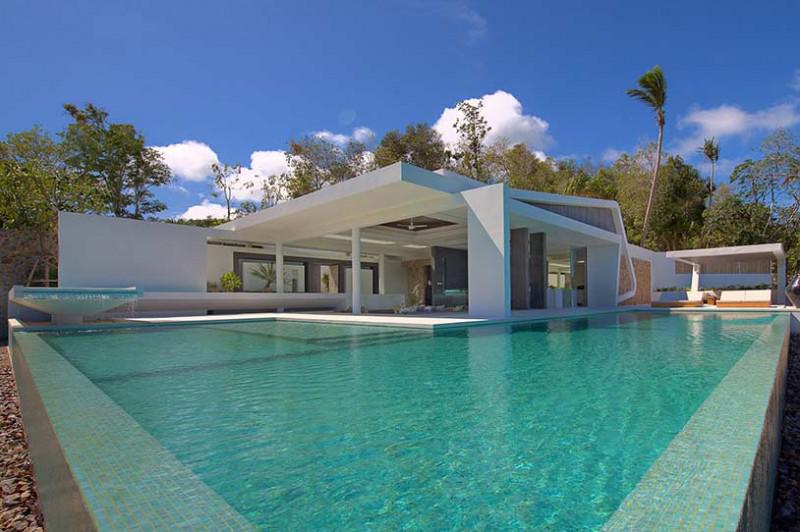 |
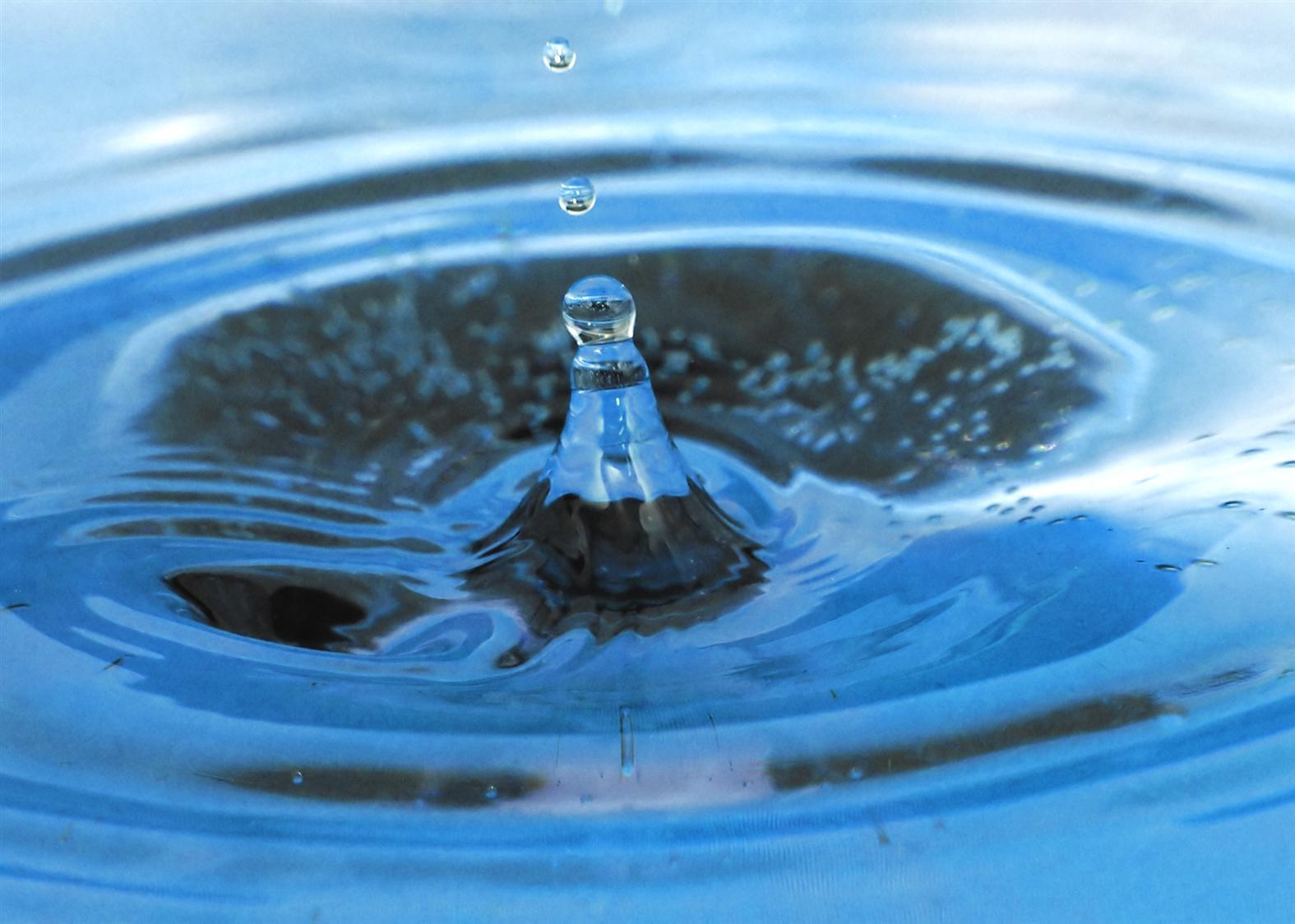
FiltrationThe filter removes particles of dust and debris that are held in suspension in the water. For domestic pools during the bathing season it is necessary to filter (turn over) the contents of the pool at least once every day. The filter pump moves the water not only through the filter but also the heating and treatment systems if fitted. Therefore in cold weather and high bathing the requirement in time for the filtration may be less than the heating or treatment. As the water temperature rises and bathing increases, so does the necessity of running the filter for longer periods. Once the pool is up to temperature, it is certainly recommended that the filter be run for at least 8 hours every day; however this may increase up to 24 hours per day. A period of 12 hours per day has been found as a good, economic compromise. It is strongly recommended that a time clock be fitted to the filter pump. This will ensure that the essential period of daily filtration becomes automated, if it is not run constantly. The pool water must always be crystal clear for safety reasons. If the water becomes dull or cloudy, the pool chemistry must be adjusted, and then the filter should be run for 24 hours per day until sparking clarity is regained. A high wind or a bathing party, will introduce an excess of debris into the pool and the pool water can go cloudy overnight. Continuous filtration, possibly with the use of a flocculent*, will quickly restore the clarity of the pool. |
|
Cleaning or backwashing the filterThe filter will take out fine particles from the water and will consequently become partially blocked after a period. On the filter is a pressure gauge. The pressure will rise as the filter becomes dirty and this indicates when backwashing should be carried out. Note the pressure when the filter has been backwashed and the media is clean. This is called ‘the clean running pressure’. When the pressure has reached 0.3 bar (or 5 psi) above the clean running pressure, the water flow around the pool will be consequently lessened, and the filter should be backwashed. However it is a simpler task to backwash the filter on a regular basis. With an outdoor pool this is normally once per week. Periodical chemical cleaning of the filter, by means of a proprietary cleaner is desirable for optimum performance. *A chemical which, when added to the pool water, causes fine particles to collect together and form larger particles more easily removed by the filter. Sand filter backwashing
Note: DO NOT MOVE THE MULTIPORT VALVE WHILE THE PUMP IS RUNNING and always move the lever in the same direction for longevity of the spider gasket. Pump coarse strainerIn front of the pump is a coarse strainer basket. The purpose of the coarse strainer is to prevent any debris entering the pump and causing damage to the impellor. This is accessible by undoing the screw thread, or lid clamping device and removing the lid. The basket can then be removed and emptied. However to prevent the water from flowing back into the pipes to the level in the pool, the suction valves in front of the pump and the multiport valve should be closed before cleaning and opened afterwards. After using a skim-vac-adaptor and vacuuming through the skimmer basket, the coarse strainer will require inspection. However, when vacuuming through a vacuum point, all the debris will be trapped on the pump coarse strainer, which will have to be cleaned after and if necessary during the pool vacuuming. When replacing the lid of the coarse strainer, make certain that the gasket and top are thoroughly clean and screwed up tightly to form an air-tight fit, and that the gasket is correctly positioned. |
|
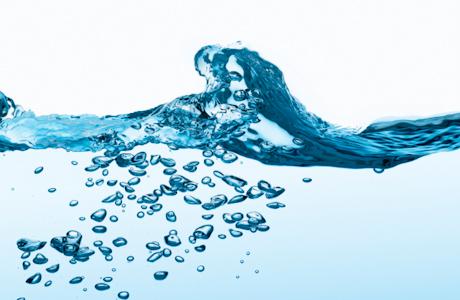
Valves in front of circulation pumpThere are usually two or three valves in front of the pump; one controls the skimmer line(s) and the other the main drain. During normal running, both valves should be open to ensure maximum circulation. When using a pool vacuum, if this is operated off the skimmer, the skimmer valve should be fully open and the other valve closed to give maximum suction. On large pools there are sometimes three or more valves fitted in front of the pumps. The other valves control the vacuum line or additional skimmers. |
|
Chemical treatmentsThe recommended chemical treatment for a particular pool may vary according to the nature of the water to be used. It is a good idea to have the water balanced for you by your pool maintenance company. Ask them to explain the process in simple terms. There are two basic needs for pool water treatment in order to provide bather comfort and protection:  |
|
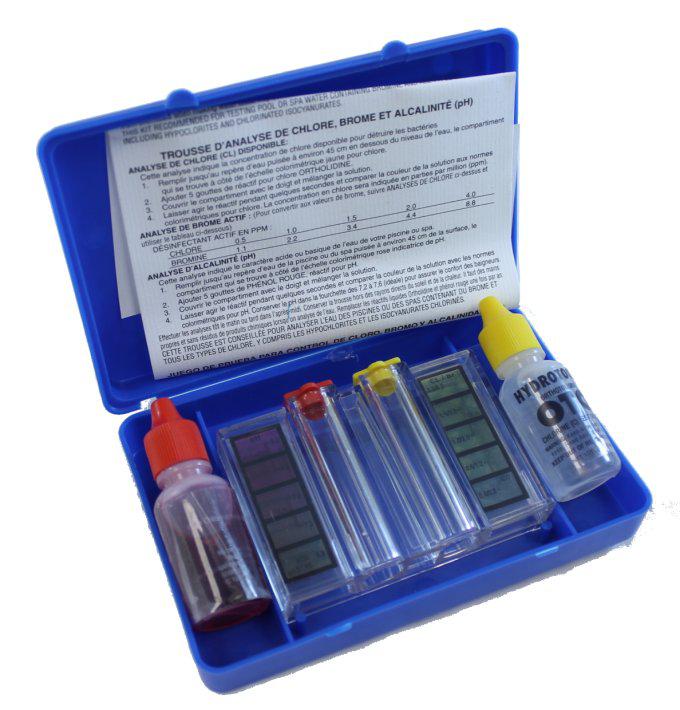
Control of pH.pH is the scale indicating the degree of acidity of the water. The logarithmic scale used for pH reading is 0 to 14, with the middle point at 7.0 – below which the water is acidic and above which is alkaline. The recommended range of pH in swimming pool water is between 7.2 and 7.8. Where the pool water falls below pH 7.2 there is a risk of corrosion of metals and of the pool finishes. Where the pool water raises above pH 7.8 some disinfectants are not so active and there may be problems of scaling due to precipitation of calcium salts from the water. The pH is adjusted to the range of 7.2 to 7.8 by the use of acid when the pH rises above 7.8 and alkali when the pH falls below 7.2. Regular addition of pH correction chemicals, as necessary to maintain the ideal pH, will protect the pool, its equipment and the swimmers. It may be necessary to control total alkalinity and calcium hardness to ensure good water balance. If in doubt, seek the advice of your local SPATA maintenance company. |
|
Control of disinfectionDisinfection of pool water is carried out to rapidly destroy micro-organisms that may be harmful to the health of swimmers. It is a prime requirement of swimming pool disinfection that an adequate residual is maintained in the water at all times. There are a number of disinfectants available for swimming pool treatment. One will have been selected by your Pool Installer for your use. You will be advised of the level of residual required, it’s testing and method of addition to the water, and you should be given the manufacturer’s literature on the system chosen. The use of Chlorine, in its various donor forms, is still considered to be the safest, best and easiest means of rendering water safe to bathe in. If using chlorine then a reading of 1.0ppm / mg/ltr (at pH 7.2) is the lowest safe limit without backup of ultra violet or ozone, but generally 1 to 1.5ppm / mg/liter is considered to be ideal. Periodic shock dosing will raise the level to 10 / 12ppm mg/liter, this is generally accepted to be a safe upper limit, for a short period and should ideally be done after the bathing has ceased for the day. A number of pool disinfectants are effective in controlling algae growths, while others have only limited algaecide properties. Your SPATA Pool Installer will advise you regarding the need for an algaecide and all other special treatments required in your particular pool. Remember the responsibility for looking after your pool rests with you after the handover by your pool Installer. Ensure you note well the advice given on chemical treatments. 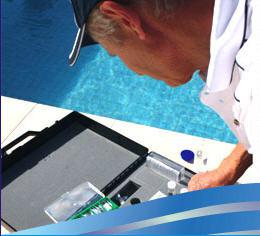 |
|
Automatic testing and dosing equipmentThere are a number of systems on the market that electronically test disinfection and ph level of swimming pool water. Some computer based machines actually dose the required amount of adjustors internally, whilst others can be fitted with feeding devices for the chemicals from separate containers. Testing, safety and handling of chemicalsYou will need a test kit, to test for disinfectant and pH using a simple color comparison method. The kit will contain specific instructions as to its operation. In most kits tablets will produce a color change in a test sample of water. Compare the color of the test liquid with the standard colors on the test kit; the nearest match will be the level in the pool. Do not expect to see an exact color match, as both natural and artificial light may alter the matching. The best result is taking a reading in natural daylight with a white piece of card or paper behind the test cell when looking at it. It is vital that, having tested, you consider the results and dose the pool according to the instructions. |
|
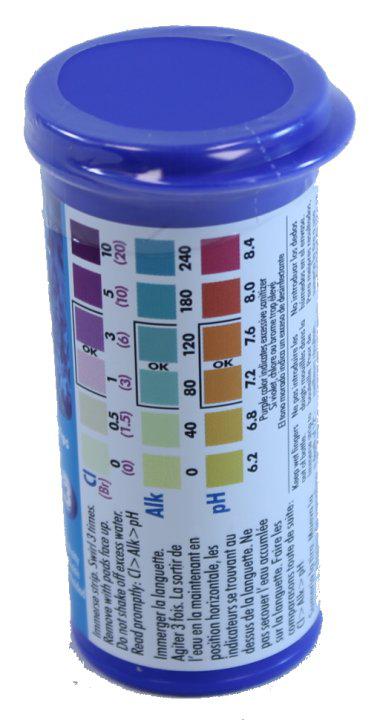
Safety tipsAll pool chemicals are potentially dangerous and must be treated with care All chemicals are supplied to you in clearly marked containers noted with instructions on use and storage.
|
|
Cleaning your poolPool vacuumSome dust and debris will blow into the pool and accumulate on the pool floor. This can only be removed with a pool vacuum or automatic pool cleaner. New pool owners may experience a little trouble in operating the vacuum for the first time, and the following technique is suggested:
 |
|
Vacuum to wasteIf the floor is very dirty it is best to vacuum to waste, which is the quickest way to vacuum without blocking up the filter. Commence vacuuming in the normal way, and then stop the pump and re-position the multiport at ‘waste’ (if a valve is fitted on the waste line, open this before switching on the pump). Recommence vacuuming. All the water is sucked out, by-passing the filter and pumped out to waste along the backwash line. This operation reduces the pool water level, which must be topped up. It is therefore advisable to overfill the pool before the cleaning process. If pool vacuum stops operating This can be due to the following:
Automated cleanersThere are several makes of automated cleaners, which divide into vacuum, pressure and electric self contained cleaners. Electric cleaners have strainers and filters that will require cleaning on a regular basis. If you are not sure of what needs doing consult your pool maintenance company. For safety reasons, due to the potential for entanglement and entrapment underwater, then hoses and cables along with cleaners must be removed from the pool before swimming |
|
Heating your poolPool heater, whether heat pump, gas, electric or oil are fitted with a thermostat to keep the pool at a controlled temperature. Solar panels are controlled by a differential temperature control to activate the system whenever solar heat is available for collection. It is important that you identify the temperature you require in the pool, the available fuels on site, and therefore the best system to suit your requirements. Whether you have an oil or gas-fired boiler or heat pump, remember that these units require servicing and winterization in the autumn by your pool maintenance company to keep them in good condition.  |
|

Pool temperatureTemperature is very much a matter of personal preference, but diligent use of the heat retention cover, coupled with the very efficient modern heaters available enables the pool to be kept at an acceptable temperature, economically. Some notes on the methods to heat your pool are below. Heat pumpA heat pump is quite simply a refrigerator, which is trying to cool the atmosphere and put the heat collected into the pool water, as opposed to the domestic refrigerator which is cooling your butter, milk etc and putting the heat from those items into the atmosphere in the kitchen. For the technically minded, the operation is achieved by a large cylindrical fan in the heat pump which moves air through the unit. The air, which is relatively warm, passes over an evaporator containing a liquid, which boils at very low temperature. When the liquid boils, it turns to a vapor. This vapor is pumped into a compressor and compressed which increases its temperature by five to six times. This hot gas is then pumped into a heat exchanger where it heats a metal coil as it passes through it; the pool water circulates through the heat exchanger on the outside of the coil, picks up the heat and takes it back to the pool. Therefore the pool water cannot be heated unless the filter pump is circulating the water and, of course, the heat pump is switched on. The heat pump is very efficient and depending on the outside air temperature can return 3 to 5 more units of heat per unit of electricity than if an electric heater on its own were used. This method of heating is classified as “low grade” heat. This means that to heat the pool water you will, at the beginning of the swimming season, have to run the heat pump, and consequently the filter pump, for 24 hours per day until the desired temperature is achieved. Thereafter the running time can be cut back to 10 to 12 hours per day. It is important to have a heat retention cover on the pool to conserve the heat otherwise the heat pump efficiency is lost particularly at night. During the heating process the heat pump will produce condensation which will drip out of the discharge pipe outside the plant room. This is a good indication that the machine is working. However at the beginning and end of the season the air temperature can get quite low even to the point when this condensation will freeze. No harm will come to the heat pump, as it will sense this. However in doing so the compressor will switch off and the fan will continue to move air through the heat pump trying to warm it up and de-frost by itself. It is important that the circulation of air is not restricted in its passage through the plant room, the heat pump, and thereafter out of the plant room. That is to say the air vents or windows must always be open and wheelbarrows, bushes, chairs etc must not block the discharge vent. The front of the heat pump should not be covered but kept clear; periodically dust debris, flies etc should be brushed off. Remember the indications that the heat pump is working are:
|
|
Electric heaterThe heater works in the same way as an electric kettle although very much larger. Most have a series of “status” neon lights, which indicate whether or not the elements are working. They also have a dedicated neon to indicate whether the power supply is on. This will stay on even when the filter pump is off. The heater is controlled by the on/off switch on the pool control panel and also by the large switched fused isolator alongside. The heater will have on it a pool water thermostat. Once the pool water is up to the required temperature the heating elements will be switched off. These heaters are neat, clean and easy to install, although obviously a registered electrician must make the electrical connection. Depending on the connection, they may able to function either with or without a cheap rate tariff. The electrical supply into the property must be competently checked before installation to ensure that an adequate supply is available. If the electric heater does not contain a flow switch then one must be installed to operate the heater on / off with water flow through the system. Heat exchangerThe heat exchanger has an outer shell which contains a multitude of small bore tubes; imagine a kitchen mug on its side and full of children’s drinking straws. The hot water from the house boiler circulates between the “mug” and the “straws”; the pool water flows through the “straws” and is heated by them. The two waters do not mix.
If the pool water requires heat, then a signal sent by the thermostat will operate the boiler and a circulating pump turns on and draws water from the central heating system to the heat exchanger. When heat demand to the pool water is satisfied, a further thermostat signal will turn the boiler off. Therefore to heat the pool the following must happen:
Gas heaterGas heaters, whether they are fuelled by natural gas or propane must be installed by a registered Gas-Safe fitter in accordance with the current regulations. These include the size and position of the flue, the gas supply and the ventilation. Some gas pool heaters are designed to stand outside a building in the open and in this case there is no flue. However positioning is important and again must be in accordance with regulation. Three separate switches control the heater:
The heater has three safety devices:
With modern technology, thermometers are very accurate with a digital display, so simply set it to the desired temperature. With older models, the easiest way to get your desired temperature is to turn on the filter pump to run constantly, until it has reached the desired temperature. Turn the heater ON, both on the main control panel and the heater, and turn the thermostat to maximum. Put your pool thermometer into the pool water and when that reaches your desired temperature return to the plant room, turn the heater thermostat down to the position where the heater just goes out; the thermostat setting will then match the pool water temperature and will then maintain that temperature in the pool. Most new gas heaters have electronic ignition, but on older models, should the heater pilot light go out, re-lighting instructions are usually set out on the inside of the front door, or in the appropriate instruction booklet. Always ensure that all air vents are clear and/or the ventilation is not hindered. Oil heaterOil heaters have long been used to heat swimming pool water. A few are available that have the pool water flowing directly through them and operate in a manner similar to the Gas Heater (described above). In some cases, they are standard domestic or commercial boilers which are connected to the pool water via a heat exchanger. In this case the oil heater can either be the main house boiler with the heat exchanger added to the system in a manner similar to an additional radiator, or as a stand-alone boiler. In the latter case the boiler will need to be fully installed with either a header tank or expansion vessel and connected to the heat exchanger with a set of primary flow and return pipes. As with the gas boiler the flue and ventilation requirements are critical but at present are not covered by direct legislation. However care must be taken when positioning the boiler to ensure that flues do not terminate close to windows, to boundaries etc. Additionally stand-alone boilers will require connection to an oil supply whether existing or a dedicated tank. |
|
Solar panelsThe concept of the solar heating system gathering free heat from the sun is attractive and will work. However in this climate it is unreliable at maintaining a constant temperature in the pool. The usual heat input from a correctly sized solar panel system is 2-4°C (35-39°F) above the natural temperature of the unheated water; the higher rise occurring at the at the hottest part of the season. The panels are controlled by a differential controller that is set to measure the temperature of the water and the temperature of the air. When the air is sufficiently warmer than the water the pool water flow through the panels will be started. (Otherwise the heat from the pool would radiate to the air!). Standard pool solar collectors require a bank of panels’ equivalent to approximately 75% of the surface area of the pool depending on the geographic location. Ideally the bank should be angled at 15° to 45° degrees to the horizontal and be facing south. The distance between the filter pump and the panels must be taken into consideration when designing and siting such a system. Solar panels are most effective when combined with another fossil fuel heater or heat pump. 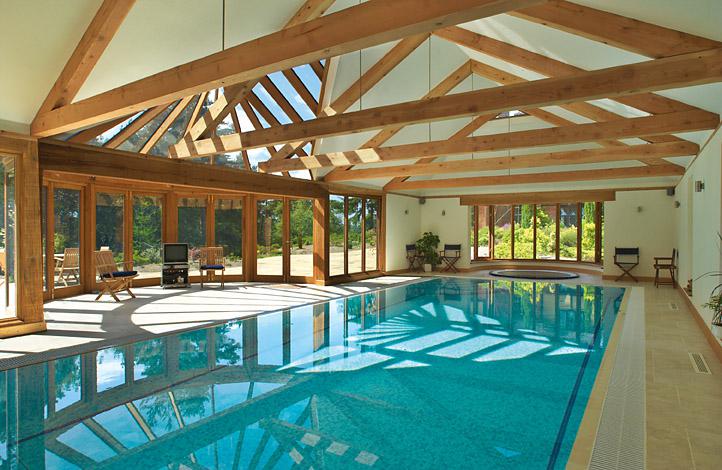 |
|

Indoor pool heatingIndoor pool water can be heated by any of the options listed above although solar heating is rarely used. However not only does the pool water have to be heated but also the space above it in order to keep down condensation that will damage the structure of the pool hall if allowed to build up. This will require the installation of an air-handling unit with a distribution system for de-humidification. Consequently it is important that each system is designed separately and separate instructions issued. |
|

Pool coversThere are several different types of pool covers available, fulfilling different functions. Heat retaining covers These are primarily used to conserve heat by preventing heat loss from evaporation and cold winds. These covers float on the pool surface and do not require fixing. For ease of handling pool reels are available. There are several types available, the most popular being the bubble cover, which saves heating costs and gives free solar heat through the blanket to increase the pool temperature. Floating covers do prevent a lot of debris from entering the pool but need careful handling when removing or the debris will fall back into the pool. When winterising the pool, remove the cover, and thoroughly dry and store it away, carefully, over the winter. (If the cover is left lying on the pool in icy conditions, the cover will deteriorate.) The use of a suitable roller will simplify the handling of the cover which must NEVER be left rolled, folded or exposed to strong sunlight. |

Winter debris coversA winter cover, suspended across the pool, will keep put out the majority of leaves, debris etc. The cover is made approximately 60 cms (2ft) longer and wider than the pool to give the necessary overlap, and is normally provided with special fixings that simply slot into holes drilled into the surround paving. When installed, the cover straps should be tightened so that the cover is tight fitting and it should be re-examined a few days after initial fitting and any slackness eliminated. These winter covers keep out debris and leaves, but allow any rain to pass through. Please note that even if this type of cover is maintained in good condition and is firmly anchored, it must not be assumed that it will offer any degree of safety. There are certain trees that have very unpleasant habits during the spring: willows and poplars for instance shed white feather debris for which the winter debris cover is invaluable. It is desirable to keep the cover clear of the water at all times, although a snow load will push the cover on to the water where the water will support that extra weight. If your cover becomes blocked into ice, leave it alone or you will damage it. Storage of coversBefore storing the cover, remove all of the debris and clean it. Store away from excess heat and also from concentrated chemicals. NEVER clean the cover with solvents, as this will cause it to shrink. Automatic coversFor added safety and ease of operation, power operated lockable covers are available in either fabric or plastic slatted materials. There are no swimming pool covers that are 100% safe and therefore in curtain circumstances, other measures (such as fencing) might have to be considered dependant on each individual case. |
TroubleshootingPump primingSome difficulties may be expected in priming the pump at the commencement of the season. The following procedure is suggested:
If the pump will not prime, there is probably an air leak in front of the pump. It could be that:
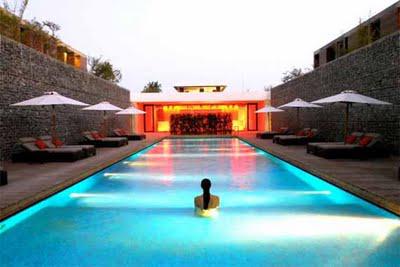
On older pumps, if the priming is difficult, there may be a leak between the pump and the pump motor. A worn pump seal will suck air and make priming difficult and should be |
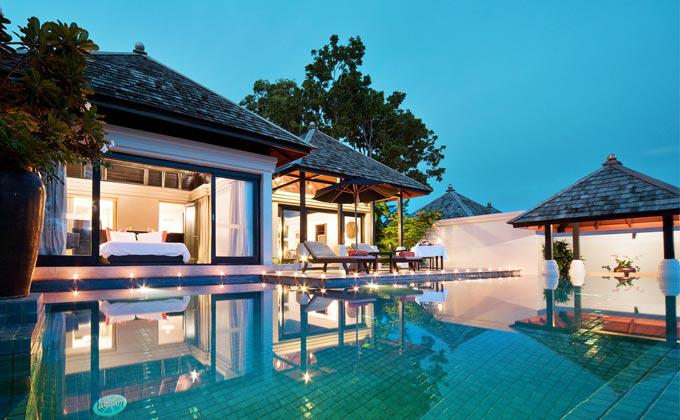
TroubleshootingGeneralProblem Cause SolutionElectric motor will not start:
Pressure gauge is abnormally Low:
Pressure gauge is abnormally High:
|
|
Water is cloudy, not crystal clear:
Walls and floor are slippery:
Hole in swimming pool vinyl Liner:
|
|

Water Flow Coming From Pool
All Plumbing and Fittings must be SCH-40 PVC. 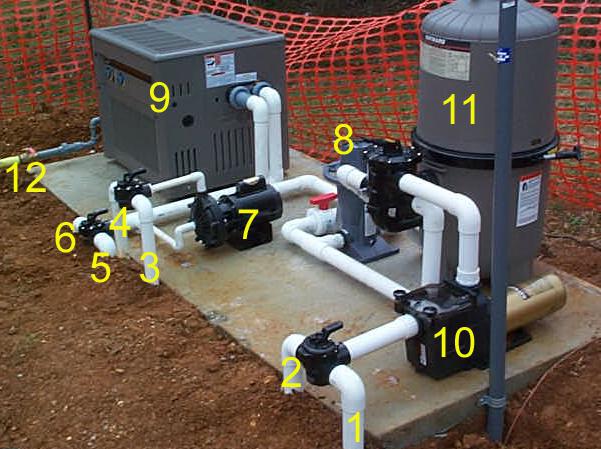
Flow Returning To Pool
Pool Equipment
|
|
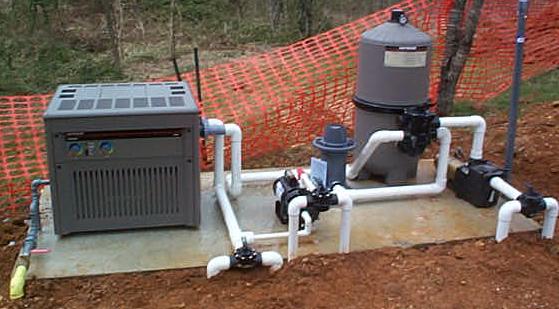 |
|
 |
|
